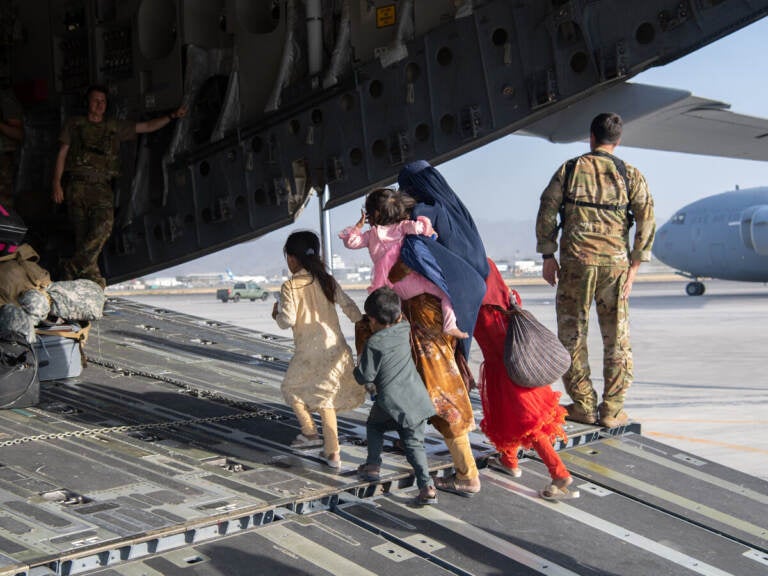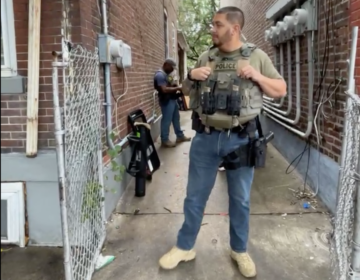Families were split up during Afghanistan evacuations — and are still not reunited

A family enters a U.S. Air Force plane in Kabul, Afghanistan, on Aug. 24, 2021. The evacuation was part of a U.S. effort to relocate Afghans to safety in the wake of the Taliban siege. But many families were separated in the process — and reuniting them has proven to be a challenge. (Master Sgt. Donald R. Allen/U.S. Air Forces Europe-Africa via Getty Images via NPR)
Last spring, H.M., an Afghan refugee living in the U.S., visited Kabul to get married.
He spent a few blissful months with his new partner before returning to the U.S., where he is a legal resident. He immediately applied for a spousal visa for his pregnant wife. But in August 2021, the Taliban took over Afghanistan and the U.S. embassy shut down — and there was no one to process her visa.
(H.M. asked to be identified by his initials to protect his family, who are at high risk of persecution by the Taliban.)
His wife then applied for a special immigrant visa with the U.S. government. Because she worked for a USAID program in Kabul, she qualified for the visa, granted to those who’d worked with Americans on U.S.-sponsored projects. But she never received a case number due to bureaucratic delays.
The couple is still living apart. In December, H.M.’s wife gave birth to a daughter whom he has yet to meet – although he’s already making plans to give her tennis lessons.
H.M.’s story represents a category of Afghans who have been separated from their loved ones in the wake of the Taliban takeover — and aren’t sure if and when they can reunite. Deborah Alexander, a former U.S. diplomat in Afghanistan who is assisting H.M.’s wife and other Afghans with asylum and visa applications, estimates that thousands of families have been split apart.
The U.S. and its NATO partners promised to get Afghans whom they’d trained, armed and funded out of Kabul last summer along with their families. This includes Afghan soldiers , interpreters and advisers directly employed by the U.S. — and those who worked for U.S. and NATO-funded organizations and projects. Because of their affiliation with Western powers, these Afghans are in danger of persecution by the Taliban.
The U.S. was able to relocate more than 124,000 at-risk Afghans to safety after the Taliban took over, according to the State Department. But those efforts have slowed to a trickle. The U.S. government has not been able to negotiate with the Taliban to allow other Afghans to leave. So many of them and their families remain stuck in Afghanistan.
Families divided
H.M. worries about his wife’s safety, says Alexander, who is based in the U.S. and works on her own as a volunteer to help a few Afghan refugees. The retired diplomat not only helps Afghan refugees adjust to their new lives when they arrive in the U.S., but also helps those still at risk in Afghanistan apply for visas and make asylum applications in the U.S. and other countries. Much of her work involves advocating for Afghans with the U.S. and foreign governments, filling out forms, writing letters and connecting vulnerable Afghans to individuals and NGOs who can assist them financially if needed.
(In fact, there was standing joke in one of the Facebook evacuation groups that if Hollywood were ever to make a realistic movie about the work of evacuation activists, it would feature retired diplomats and veterans at their laptops filling out forms, writing emails, editing statements about threats to those still in Afghanistan, managing Excel spreadsheets of vulnerable groups and begging officials to accept “their Afghan families.”)
The USAID project that H.M.’s wife worked on focused on increasing the presence of women in the Afghan government. That likely “won’t be viewed favorably by the new Taliban regime,” says Alexander.
H.M.’s wife is caring for their baby alone. And, Alexander adds, “she’s a Hazara woman,” referring to the persecuted Afghan ethnic group.
H.M. wants to return to Kabul to be with his wife and child. But that would be dangerous, says Alexander. So she is doing everything she can to help the family with their paperwork – and “stop the husband from getting on a plane.”
That includes urging different U.S. officials to give priority to the family’s case if evacuations restart and getting mental health support for H.M. to deal with the trauma of being separated from his family.
Alexander is also helping a woman who asked to be identified by her initials, Z.N. Last summer, she, her husband and three children were trying to leave Afghanistan. Z.N. was a former officer in the Afghan police, which received training and support from NATO, and her husband was a veteran who served in the U.S.-backed Afghan forces and was injured in a Taliban attack. The family feared that if they stayed in Kabul their lives would be in danger.
But when they headed to the airport on August 26, there was an explosion — and Z.N. was separated from her family. Z.N. managed to get inside the airport and on a flight to the U.S.
In the airplane, Z.N. hoped her husband and kids got on another flight – and worried that they had been injured or killed. She arrived in the U.S. distraught about the fate of her family.
“She was eventually able to contact her husband to verify that they had survived, but they had not gotten on a flight,” says Alexander. Nearly six months later, Z.N. is still separated from her husband and children, who are still in Kabul.
A rocky road to reunion
For Z.N. and H.M., it’s hard to remain hopeful.
Alexander, who previously worked for the State Department and has also worked on evacuation efforts in countries like Iraq, Croatia and Serbia, acknowledges that U.S. efforts to pull Afghans out of the country last summer were messier than usual.
“It was also the end of a 20-year war, and the collapse of a government that no one anticipated would fall so quickly. And there was no planning, preparation and training [on the part of the U.S.] for a massive evacuation,” she says.
The fact that U.S. authorities weren’t able to get H.M.’s wife on a flight out of Kabul is an example of that, says Alexander. “The U.S. government should have given her priority in the evacuation since she is the wife of a U.S. legal permanent resident.”
What’s more, the protocol to bring Afghans and their families to the U.S. lacks clarity. “Whatever evacuation process is in place by private organizations or by the U.S. government is opaque,” says Alexander. Nongovernmental groups and volunteers aren’t coordinating with each other about which Afghans they’re choosing to evacuate, she adds.
Responding to the criticism, a State Department spokesperson told NPR they have a team coordinating across government agencies and with advocacy groups, nonprofits, and others “to facilitate the departure of those who wish to leave Afghanistan, including U.S. citizens, Lawful Permanent Residents (LPR), our Afghan allies and their eligible family members.” They said the U.S. government has been working on individual cases of reuniting separated family members. “We are committed to reuniting families, especially parents and minor children, who may have been separated during relocation operations in August 2021,” they said, without sharing specific details.
“If an individual in the United States was separated from their spouse or child(ren) (or in the case of unaccompanied minors, their parents or primary caregivers) by the NEO [ non-combatant evacuation operation] in August 2021, we encourage them to be in touch with their resettlement case manager,” they said.
Meanwhile, Afghans who were able to come to the U.S. and receive humanitarian parole through the U.S.-led evacuations last year, like Z.N., have their own set of problems. Their initial visa expires after a period of two years. So they need to apply for asylum during this time period to secure permanent legal residency. However, over 36,000 Afghans are ineligible because they didn’t work directly for the U.S. or its partners, according to the U.S. Department of Homeland Security. For example, although Z.N. was a police officer with NATO-backed Afghan forces, she was not technically employed by them. So it’s unclear what will happen to her and others when their visa runs out..
Activists are putting pressure on congresspeople to pass the Afghan Adjustment Act to help these ineligible Afghans stay. Sponsored by Rep. Adam Kinzinger (R-Ill.), the act allows Afghan evacuees to apply for permanent status after one year of entering the country.
“This very important act can grant them asylum like it did for the Vietnamese [in 2000] and Cuban immigrants [in 1966]. Many human rights groups, veterans and diplomats are supporting it. We are really hoping for that because it will certainly make [Z.N.]’s case easier,” says Alexander.
Meanwhile, Alexander says she is helping the Afghan refugees adjust to their new reality in the U.S.
She says Z.N., who like many Afghan refugees gets support from the U.S. government and from charities, “is starting to get her feet on the ground. She has an apartment, clothes — and is learning the language and how to ride a bus. But she is still traumatized as someone alone in a new country, away from her children and her husband. She is spending most of her time thinking about being with them.”




